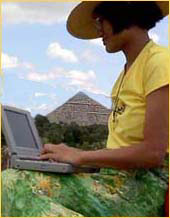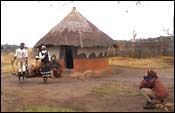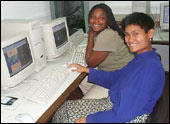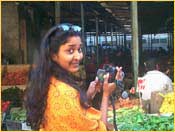
How We Do What We Do!
 |
The five Team Members themselves decide how best to cover the itinerary and select who will cover what. They use local travel options and are left to themselves to figure out what those might be. We rely heavily on guidebooks donated by Lonely Planet to help us with this.
Each of the Team Members has with them a laptop computer and a digital camera. The laptops are various models donated by Viant Corporation. The cameras are Kodak DC220s, allowing the Team to capture and store digital images along with up to 30 seconds of sound per photo. These photos and sounds are in turn stored on the laptops.
 |
To minimize Internet time, which rarely comes cheaply, the Team prepares all of their content, which includes the dispatches, caption info, and logistical and personal information for the stateside team, on the laptops and transfers this to floppies. While the Team has the equipment necessary to connect to virtually any phone line to dial in to local Internet Service Providers, they have not once had to do this. The massive proliferation of "cybercafes" - shops selling time on computers connected to the Internet - has allowed them to rely almost exclusively on these ready-to-go connections. The Team Members certainly spend a lot of time where there are no connections (the ten days without word from three of them as they plied the coast of Colombia was nerve wracking!), but at least a couple of them are always able to send content when others can't.
 |
 |
In some places they have designed web pages for local cybercafes in exchange for free time, in others an acknowledgement on the website has proven a nice incentive, and some local institutions such as the American University in Cairo donate time just to help the cause.
The Team sends the content to The Odyssey's stateside team via three e-mail accounts - the redundancy that we've found ensures that all of the content makes it - and sometimes uploads the content directly to a part of the website that isn't public. Content is sent in by the Team to meet two deadlines that correspond to our two weekly updates on Wednesday and Saturday afternoons.
 |
Over 50 people in our stateside office in San Francisco take over from there. The content is reviewed and supplemented (with vocabulary boxes, links to other sites, etc.) by the Editorial Team, and then optimized and posted to the website twice a week by the Web Team. The website is hosted for free by Verio, which has donated more server space than is typically allocated to top-of-the-line corporate sites. The stateside people can turn everything around in under two days, allowing us to keep the website up to date.
Most of the stateside team works out of office space donated by Viant Corporation, on six multi-media ready desktop computers donated by various local companies, though many work virtually from their own computers at home or work.
 |
What about the video and music? These are special cases because of the extra support required to capture, upload, and host the content. The Team shares three donated Panasonic PV DV910 digital video cameras. This allows them to capture high-quality video on very small, light-weight tapes. This video is then converted right there in the field into the low-resolution video format we post on the website. This is done using the Internet Version of Dazzle Multimedia's Digital Video Converters, three of which Dazzle donated. This allows the Team to regularly send very small video clips appropriate for regular e-mail. These clips are then edited stateside and hosted by Star Media on their video servers, which we link to from our website.
The music (where noted) has been donated by Putumayo World Music who made available to us their full collection of CDs. Star Media converts the samples we select into web format and hosts these on the same servers as the video.
There are about ten other volunteers who work in capacities such as Executive Director, Program Director, Editorial Director, Applications Coordinator, Outreach Coordinator, and Curriculum and Itinerary Developers who help keep it all running smoothly and meet our other responsibilities as a non-profit.
The Odyssey is a 100% volunteer organization, with all of these people from the World Trek Team to the stateside staff giving freely over 500 hours of their time every week.
What money we receive comes primarily from Foundations such as the Haas Fund and the eBay Foundation in the form of grants, as well as many small donations from individuals.
All of this allows us to make the high-quality multimedia content you see on the site, including all of the teacher support materials, available to teachers, students, and families all over the world at any time for free.
So there you go! That's all there is to it, so you can go out there and do your own World Trek now! Enjoy!
![]()
![]()
![]()
![]()
![]()
![]()
![]()
![]()
![]()
![]()
![]()
![]()
![]()
©2000 The Odyssey: World Trek for Service and Education. All rights
reserved.